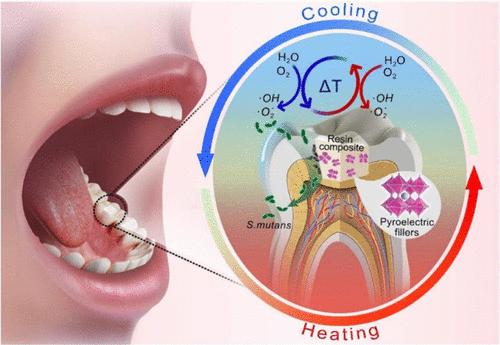Self-Bactericidal and Long-Lasting Resin Nanocomposites with Pyrocatalytic Activity Regulated by Oral Temperature Fluctuation
IF 8.2
2区 材料科学
Q1 MATERIALS SCIENCE, MULTIDISCIPLINARY
引用次数: 0
Abstract
The design of antibacterial functions in dental resin composites is a key approach to preventing secondary caries. Although conventional composite resins incorporated with antimicrobial agents can indeed exhibit bactericidal effects, these lack long-lasting antimicrobial activity and may exert cytotoxic effects, thus, causing biosafety concerns. Here, we developed a universal, nondestructive, and self-bactericidal strategy for fabricating dental resin nanocomposites without additional devices or power sources. This was achieved by incorporating a ceramic nanofiller with pyrocatalytic activity, which is activated by ubiquitous oral activity-induced temperature fluctuations. By optimizing the content of BaSrTiO3 (BST) pyroelectric fillers, the BST-resin nanocomposites exhibited a positive pyroelectric effect, as well as reactive oxygen generation capacity under physiological temperature fluctuations associated with food/drink intake and speech. The initial adhesion and growth of S. mutans were significantly inhibited by pyroelectric BST-resin nanocomposites. Subsequent biofilm formation was suppressed by pyroelectric effects activated by temperature fluctuations. Moreover, the pyrocatalysis-based resin nanocomposites displayed excellent therapeutic biocompatibility and excellent mechanical properties, which are comparable to those of commercial resins. Hence, our findings provide an innovative strategy for addressing the antibacterial technical requirements of dental resin nanocomposites.

口腔温度波动调节热催化活性的自杀菌长效树脂纳米复合材料
在牙用树脂复合材料中设计抗菌功能是预防继发性龋病的关键途径。虽然传统的复合树脂加入抗菌剂确实可以表现出杀菌作用,但这些树脂缺乏持久的抗菌活性,可能会产生细胞毒性作用,因此引起生物安全问题。在这里,我们开发了一种通用的、非破坏性的、自杀菌的策略来制造牙科树脂纳米复合材料,而不需要额外的设备或电源。这是通过加入具有热催化活性的陶瓷纳米填料来实现的,这种活性是由普遍存在的口腔活动引起的温度波动激活的。通过优化BaSrTiO3 (BST)热释电填料的含量,BST-树脂纳米复合材料在食物/饮料摄入量和语言相关的生理温度波动下表现出积极的热释电效应,以及活性氧生成能力。热释电bst -树脂纳米复合材料可显著抑制变形链球菌的初始粘附和生长。随后的生物膜形成被温度波动激活的热释电效应抑制。此外,热催化基树脂纳米复合材料表现出优异的治疗性生物相容性和优异的力学性能,可与商用树脂相媲美。因此,我们的研究结果为解决牙科树脂纳米复合材料的抗菌技术要求提供了一种创新的策略。
本文章由计算机程序翻译,如有差异,请以英文原文为准。
求助全文
约1分钟内获得全文
求助全文
来源期刊

ACS Applied Materials & Interfaces
工程技术-材料科学:综合
CiteScore
16.00
自引率
6.30%
发文量
4978
审稿时长
1.8 months
期刊介绍:
ACS Applied Materials & Interfaces is a leading interdisciplinary journal that brings together chemists, engineers, physicists, and biologists to explore the development and utilization of newly-discovered materials and interfacial processes for specific applications. Our journal has experienced remarkable growth since its establishment in 2009, both in terms of the number of articles published and the impact of the research showcased. We are proud to foster a truly global community, with the majority of published articles originating from outside the United States, reflecting the rapid growth of applied research worldwide.
 求助内容:
求助内容: 应助结果提醒方式:
应助结果提醒方式:


